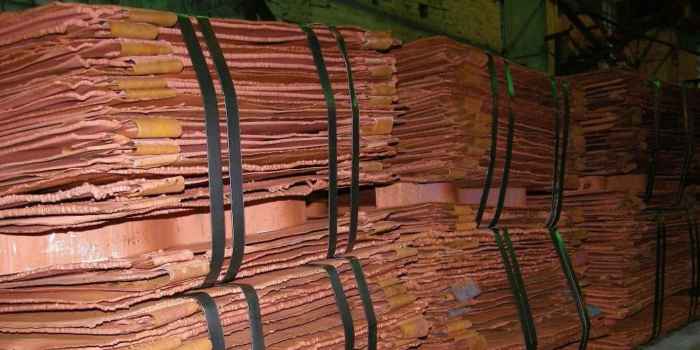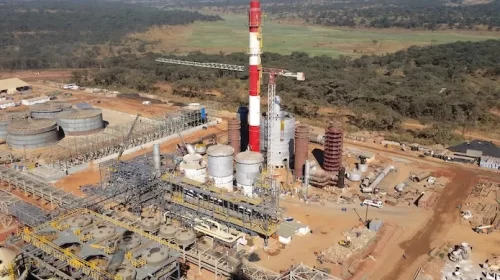The DRC among the countries to boost global copper production from 21.5 million tonnes to 27.8 million tonnes / year between 2021 and 2029
A report from Fitch Solutions predicts that global copper mine production will grow at an average annual rate of 3.7% between 2021 and 2029, with total production rising from 21.5 million tonnes to 27.8 million tonnes over the course of the same period. The DRC is one of the countries that will boost the increase in copper production in the world over the next decade.
China and the DRC are among the countries that will boost copper production in the world over the next ten years, according to forecasts by the Fitch agency.
In China, copper production is expected to grow at an average rate of 1.5% per year between 2021 and 2029, compared to an average growth rate of 4.6% over the past 10 years.
The market analyst says this slowdown in production growth will be due to closures of low-grade copper mines and delayed scheduled capacity expansions.
Despite these prospects, domestic copper production is expected to be positive as new projects come online and the Asian country develops foreign assets to improve the security of its resources.
“Chinese copper miners will remain committed to investing in overseas copper deposits to ensure access to high-quality, low-cost materials,” the Fitch document said. “For example, in October 2019, Zijin Mining announced that it would spend $ 146 million to increase its stake in Ivanhoe Mining. This purchase will make Zijin the second shareholder of the company developing the Kamoa-Kakula copper mine in the Democratic Republic of the Congo. “
Kamoa-Kakula, on the other hand, is expected to be one of the main contributors to the growth of the copper sector in the DRC, whose output is expected to grow 12% year-on-year in 2021, after contracting 3.5% in 2020.
The forecast is based on the fact that in August, Ivanhoe Mines (TSX: IVN) reported that development at the Kakula copper mine progressed ahead of schedule, with the company planning to reach the first copper concentrate at T321.
This project and others, along with the steady production of China Moly’s Tenke Fungurume mine and Glencore’s Katanga mine (LON: GLEN), are the foundation for Fitch’s prediction, which takes Glencore’s decision into account. to idle the Mutanda copper-cobalt mine from 2020 to 2022.
In the first 10 months of 2020, the DRC mining industry has already produced 1.322 million tonnes of copper and is on track, by the end of the year, to break the record. 1.4 million tonnes in 2019.
In South America
“However, the return of workers will bring copper production back to the normal range, which the company holds to around 1,200 kt per year on average,” the report said. “In addition, depending on when the above mentioned Spence Growth Option project will finally start production and can reach full rate, we expect it will also positively contribute to 2022 growth.”
The analyst points out that the forecasts for copper also count on Lundin Mining (TSX: LUG) to reach an amicable solution with its Chilean unions by the end of the year and therefore without impact on production for 2021.
Lundin projects production from the copper mine at Candelaria to be between 185 kt and 195 kt in 2021, which is up from 142 kt produced in 2019 and is expected to be higher than what is produced in 2020.
Growth after 2021 will benefit from the project’s delayed ramp-ups, such as Teck Resources’ Quebrada Blanca Phase 2 project, which is expected to begin production in the second half of 2022, Fitch says.
The development of the project had been delayed by five to two. six months due to the covid-19 pandemic, but has since restarted, and the company now estimates that copper production in the first five years will average 286 kt per year.
All of these changes have led Fitch to revise its 2022 and 2023 forecasts to 4% and 3.2% respectively, compared to 2.9% and 1.9% previously.
Turning to Peru, the world’s No. 2 copper producer, Fitch Solutions expects its copper mining production outlook to rebound strongly in 2021, growing 20% year-on-year, due to strong low base effects and commissioning of new projects.
The Andean country currently has 48 mining projects in different stages of development and 54 other exploration projects.
“Peru is tied for second largest copper reserves in the world at 87 million tonnes in 2019, 10% of known reserves,” the report said. “We believe Chinese investments will play an increasingly important role in Peru’s copper sector. Miners seek to diversify their supply chain to compensate for Chinese domestic consumption that exceeds their supply. “
According to official information, Peru is expected to see $ 10.2 billion invested in five mining projects over the next decade by Chinese companies.
![]()





